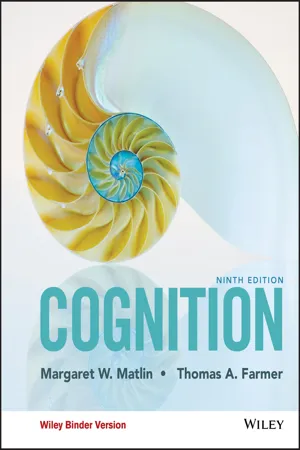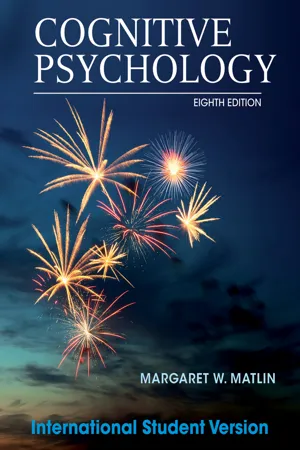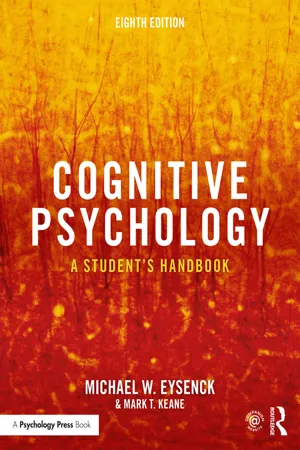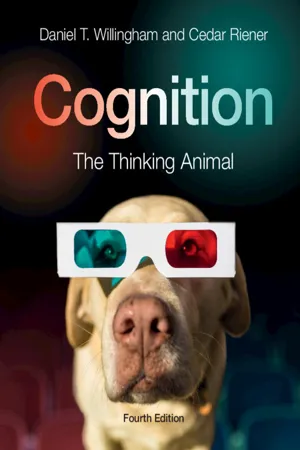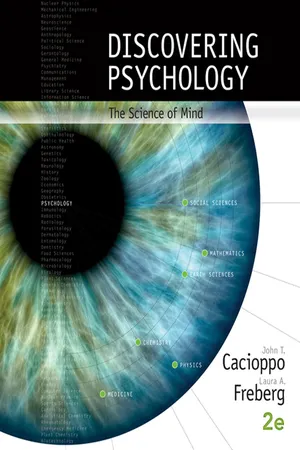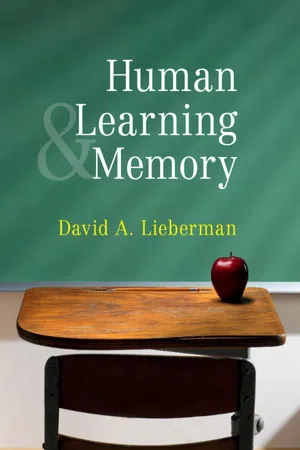Psychology
Long-Term Memory
Long-term memory refers to the storage of information over an extended period, ranging from minutes to years. It is the system of memory that allows individuals to retain and recall past experiences, knowledge, and skills. Long-term memory is believed to have an unlimited capacity and is essential for learning and forming a person's identity.
Written by Perlego with AI-assistance
Related key terms
1 of 5
9 Key excerpts on "Long-Term Memory"
- eBook - PDF
- Thomas A. Farmer, Margaret W. Matlin(Authors)
- 2023(Publication Date)
- Wiley(Publisher)
We begin with a brief overview of Long-Term Memory before turning to a discussion of key principles related to Long-Term Memory—namely, how you get information into Long-Term Memory and how you access and retrieve it. We conclude by discussing autobiographical memory—or, memory for events that you have experienced in your life. Encoding in Long-Term Memory 83 Overview of Long-Term Memory As noted in earlier chapters, psychologists often divide memory into two basic categories: working memory (the brief, immediate memory for material we are currently processing) and Long-Term Memory. Working memory is fragile—the information that you want to retain can disappear from memory after less than a minute. Additionally, the capacity of working memory is limited—you can only simultaneously process and store so much information at one point in time. Your Long-Term Memory, on the other hand, is a high-capacity storage system that contains your mem- ories for experiences and information that you have accumulated throughout your lifetime. Information in Long-Term Memory can last for a few minutes to many decades. For example, Bahrick and colleagues (1975) found that people were 90% correct at recognizing their high school classmates’ pictures and names taken from their high school yearbooks, even 15 years after graduating! Information is said to be stored in your Long-Term Memory if it is not lost or otherwise discarded by your working memory system. Psychologists often subdivide Long-Term Memory into more specific categories. These subdivisions reflect convenience, rather than a conviction that they represent distinctly different kinds of memory or are sup- ported by completely different neural systems. Classically, Long-Term Memory has been subdivided into three subtypes: episodic memory, semantic memory, and procedural memory (Herrmann, Yoder, et al., 2006). - eBook - PDF
- Margaret W. Matlin, Thomas A. Farmer(Authors)
- 2016(Publication Date)
- Wiley(Publisher)
We conclude by examining how the principles that govern Long-Term Memory can be applied to increase our understanding of real-world issues. CHAPTER INTRODUCTION BRIEF OVERVIEW OF Long-Term Memory As noted in previous chapters, psychologists often divide memory into two basic cat- egories: working memory (the brief, immediate memory for material we are currently processing) and Long-Term Memory. Chapter 4 emphasized two main features of work- ing memory: (1) working memory is fragile—the information that you want to retain can disappear from memory after less than a minute, and (2) the capacity of working memory is limited—you can only simultaneously process and store so much informa- tion at one point in time. In contrast, your Long-Term Memory is very high capacity and Brief Overview of Long-Term Memory 145 can retain material for many decades. Long-Term Memory refers to the high-capacity storage system that contains your memories for experiences and information that you have accumulated throughout your lifetime. Information in Long-Term Memory can last for a few minutes to many decades. For example, Bahrick and colleagues (1975) found that people were 90% correct at recognizing their high school classmates’ pictures and names, taken from their high school yearbooks, even 15 years after graduation! Traditionally, information is said to be stored in your Long-Term Memory if it is not lost or otherwise discarded by your working memory systems. Like many psy- chologists, however, I’m not irmly convinced that working memory and Long-Term Memory are two distinctly different kinds of memory. I do believe, however, that the division is a convenient way to partition the enormous amount of existing research and scientiic knowledge about our memory processes. Psychologists often subdivide Long-Term Memory into more speciic categories. - Lorelle J. Burton, Drew Westen, Robin M. Kowalski(Authors)
- 2022(Publication Date)
- Wiley(Publisher)
Varieties of Long-Term Memory • Declarative memory refers to memory for facts and events; it can be semantic memory or episodic memory. Procedural memory refers to ‘how to’ knowl- edge of procedures or skills. • Explicit memory refers to conscious recollection. Implicit memory refers to memory that is expressed in behaviour. • Everyday memory refers to memory as it occurs in daily life. Remembering, misremembering and forgetting • Psychologists often distinguish between the availability of information in memory and its accessibility. • People make memory errors for a variety of reasons. • Psychologists have proposed several explanations for why people forget, including decay, interference and motivated forgetting. • Memories recovered in therapy cannot be assumed to be accurate, but they also cannot be routinely dismissed as false. • Specifc kinds of distortion can also occur within the memories of people whose brains have been affected by illness or injury. Anterograde amnesia involves the inability to retain new memories. By contrast, retrograde amnesia involves losing memories from a period before the time that a person’s brain was damaged. Encoding and organisation of Long-Term Memory • To be retrieved from memory, information must be encoded, or cast into a representational form or ‘code’ that can be readily accessed. • Mnemonic devices are systematic strategies for remembering information. • Knowledge stored in memory forms networks of association — clusters of interconnected information. • LTM is organised in terms of schemas, organised knowl- edge structures or patterns of thought. Pdf_Folio:448 Information processing • sensory • verbal • motoric Short-term memory (20–30 seconds) Response Retrieval Rehearsal Long-Term Memory (enduring storage) Sensory memory A memory is a mental representation for something to be remembered.- eBook - PDF
- Margaret W. Matlin(Author)
- 2014(Publication Date)
- Wiley(Publisher)
Chapter Introduction 127 As noted in earlier chapters, psychologists often divide memory into two basic categories called working memory (the brief, immediate memory for material we are currently processing) and Long-Term Memory. Chapter 4 emphasized that working memory is fragile. As that chapter illustrated, the information that you want to retain can disappear from memory after less than a minute. In contrast, Chapter 5 demonstrates that your Long-Term Memory can retain material for many decades. Long-Term Memory has a large capacity; it contains your memory for experiences and information that you have accumulated throughout your lifetime. Like many psychologists, I’m not firmly convinced that working memory and Long-Term Memory are two distinctly different kinds of memory. However, I do believe that the division is a convenient way to partition the enormous amount of research and knowledge about our memory processes. Psychologists often subdivide Long-Term Memory into more specific categories. Once again, this subdivision reflects convenience, rather than a conviction that the subdivisions represent distinctly different kinds of memory. One popular system subdivides Long-Term Memory into episodic memory, semantic memory, and pro- cedural memory (Herrmann, Yoder, et al., 2006). Let’s briefly consider these three components. Episodic memory focuses on your memories for events that happened to you personally; it allows you to travel backward in subjective time to reminisce about earlier episodes in your life (Gallistel & King, 2009; Surprenant & Neath, 2009). Episodic memory includes your memory for an event that occurred 10 years ago, as well as a conversation you had 10 minutes ago. Episodic memory is the major focus of this current chapter. In contrast, semantic memory describes your organized knowledge about the world, including your knowledge about words and other factual information. - eBook - PDF
Cognitive Psychology
A Student's Handbook
- Michael W. Eysenck, Mark T. Keane(Authors)
- 2020(Publication Date)
- Psychology Press(Publisher)
More generally, our interactions with others and with the environment depend crucially on having an effective memory system. The wonders of human memory are discussed at length in Chapters 6–8. Chapter 6 deals mainly with key issues regarded as important from the early days of memory research. For example, we consider the distinction between short-term and Long-Term Memory. The notion of short-term memory has been largely superseded by that of a working-memory system combining the functions of processing and short-term information storage. There is extensive coverage of working memory in Chapter 6. Another topic discussed at length in Chapter 6 is learning. Long-Term Memory is generally enhanced when meaning is processed at the time of learning. Long-Term Memory is also better if much of the learning period 238 Memory is spent practising retrieval. Evidence suggesting some learning is implicit (i.e., does not depend on conscious processes) is also discussed. Finally, we discuss forgetting. Why do we tend to forget information over time? Chapter 7 is devoted to Long-Term Memory. Our long-term memories include personal information, knowledge about language, much knowledge about psychology (hopefully!), knowledge about thousands of objects in the world around us, and information about how to perform various skills (e.g., riding a bicycle; playing the piano). The central issue addressed in Chapter 7 is how to account for this incredible richness. Several theorists have claimed there are several Long-Term Memory systems. Others argue that there are numerous processes that are combined and recombined depending on the specific demands of any given memory task. Memory is important in everyday life in ways de-emphasised historically. For example, autobiographical memory (discussed in Chapter 8) is of great significance to us. It gives us a coherent sense of ourselves and our person- alities. - eBook - PDF
Studying at University
How to be a Successful Student
- David McIlroy(Author)
- 2003(Publication Date)
- SAGE Publications Ltd(Publisher)
8 KEY CONCEPTS l l l l l l l l l l l l l l l l l l Your memory may be better than you think Short term and long term memory It appears that some of the information evaporates at the short-term stage and other aspects are transferred to more abiding storage (Long-Term Memory). Although this is an oversimplification of memory structure and function (Baddeley, 1999), it illustrates the point that some memories are readily retrieved and some appear to go AWOL. Many people underestimate the power of their own memory, perhaps partly because they chiefly access their short-term memory (now more commonly referred to as ‘working memory’), or have not used good memory techniques or have not suffi-ciently focused on the large volume of information that they do remember. The human brain has an enormous capacity for remembering, and some understanding of storage and retrieval procedures will help improve memory use. There are some memories that we do not have to try to retrieve because they just spring into our conscious mind without solicitation. It is possible that these memories were important to us or we were especially interested in their content or that they were just catchy and humorous such as the following limerick: There once was a man from Trinity, who thought he’d cracked the square root for infinity; but there were so many digits, it gave him the fidgets, so he dropped it and studied divinity. Many years ago a speaker used this to illustrate the point that perhaps some people study theology because they would fail at everything else! Because there is rhyme, humour, a moral and a context, this limerick is remembered effortlessly. You should be encouraged to know that some of the things you study at college/university will stay with you and you will be able to recall them for use whenever you need them. Some years ago a mature first year student went to his tutor for advice about whether he should sit his exams. - eBook - PDF
Cognition
The Thinking Animal
- Daniel T. Willingham, Cedar Riener(Authors)
- 2019(Publication Date)
- Cambridge University Press(Publisher)
In the first section, we will ask what are the different types of Long-Term Memory? As it turns out, memories that we access consciously (like the directions) have different characteristics than memories that we cannot access consciously (like the correspondence between the angle the steering wheel is turned and the resulting angle the car will turn). In the second section, we will drill down further into the structure of the memory system associated with consciousness, which we call explicit memory. How is explicit memory organ- ized? One way to think about this question is to rephrase it by asking which metaphor for memory seems most appropriate? Is it a storehouse? Is it a filing cabinet? Is it a sortable computer database? As we’ll see, the best analogy is that memory is organized as a network. What Are the Different Types of Long-Term Memory? Preview As is often the case with mental concepts, we must begin by contrasting the common usage of “memory” with how cognitive psychologists use the term. Cognitive psychologists believe there are several memory systems, each anatomically distinct in the brain, and each using different mental processes. The everyday use of the word “memory” is close to what psychologists call the explicit system; it’ s memory we are aware of, such as general knowledge of facts, or specific events in the past. The implicit system, in contrast, represents memories we use without awareness. For example, the skill you show when riding a bike is a memory, and while we know that we can ride a bike, we are not aware of the content of the memory (the precise balances, movements, and perceptual learning) that allows us to keep ourselves on the bike and moving forward. Cognitive psychologists have also identified subsystems within the explicit and implicit systems, although the boundaries between them are not as clear. - eBook - PDF
Discovering Psychology
The Science of Mind
- John Cacioppo, Laura Freberg(Authors)
- 2015(Publication Date)
- Cengage Learning EMEA(Publisher)
Photograph of Henry Molaison. Copyright 2016 Cengage Learning. All Rights Reserved. May not be copied, scanned, or duplicated, in whole or in part. Due to electronic rights, some third party content may be suppressed from the eBook and/or eChapter(s). Editorial review has deemed that any suppressed content does not materially affect the overall learning experience. Cengage Learning reserves the right to remove additional content at any time if subsequent rights restrictions require it. 318 Learning Objectives 1. Define encoding, storage, and retrieval of memory. 2. Differentiate among sensory memory, working memory, and Long-Term Memory, as well as the subtypes of Long-Term Memory. 3. Explain the models describing the organization of long-term memories. 4. Summarize the variables influencing retrieval from short- and Long-Term Memory. 5. Describe forgetting, decay, interference, motivated forgetting, and confabulation. 6. Summarize the biological correlates of memory. What Are the Advantages of Memory? Memory is defined as the ability to retain knowledge. The problems encountered by Molaison provide us with a glimpse of how our lives would be altered without certain memory abilities, but can we make more general conclusions about how memory helps animals adapt and survive? Memory and the Continuum of Information Processing Memory does not exist in isolation. Instead, cognitive psychologists see mem-ory as part of a continuum of information processing that begins with atten-tion, sensation, perception, and learning, which we explored in previous chap-ters, and progresses to the use of stored information in thinking, problem solving, language, and intelligent behavior, which we discuss in Chapter 10 (see ● Figure 9.1). Information flows in both directions along this continuum, lead-ing to the bottom-up and top-down processing we observed in Chapter 5. - eBook - PDF
- David A. Lieberman(Author)
- 2011(Publication Date)
- Cambridge University Press(Publisher)
Part II Memory 8 Memory: an introduction CONTENTS ..................................................................................... Ebbinghaus’s memory 290 From association to cognition 295 An information-processing framework 303 A preliminary model 308 Summary 313 Review questions 314 ................................................................................................. In Chapter 1, we noted that learning focuses on the acquisition of knowledge or a skill, whereas memory refers to our capacity to later recall it. We also noted, however, that the two concepts are intimately, perhaps inextricably, intertwined. Learning necessarily involves memory: To show that you have learned a king’s name during a history lesson, you must be able to remember the name. Conversely, memory depends on learning: You can only remember the king’s name if you learned it in the first place! In essence, learning and memory are two sides of the same coin – that certain experiences have enduring effects on our behavior – and which term we use depends largely on whether we are emphasizing the initial impact of the experience (learning) or its subsequent effect (memory). Having emphasized the first aspect in the preceding chapters, we now turn our attention to memory. We are so good at remembering things that we tend to take this achievement for granted. If someone asks you your telephone number or what you ate for breakfast, you could answer immediately, and the ease with which you do so can make it hard to see what a remarkable phenomenon this is. In the course of your 290 Memory life, you have stored a huge amount of material in your brain – a vast number of experiences with families and friends, the meaning of perhaps 80,000 English words, the physical movements required to ride a bicycle or talk, and so on.
Index pages curate the most relevant extracts from our library of academic textbooks. They’ve been created using an in-house natural language model (NLM), each adding context and meaning to key research topics.

